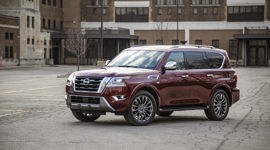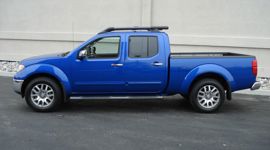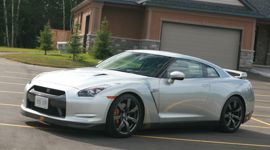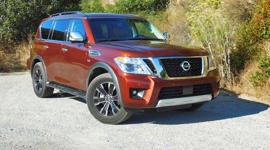 AutoTrader SCORE
AutoTrader SCORE
-
STYLING5/10
-
Safety8/10
-
PRACTICALITY8/10
-
USER-FRIENDLINESS6/10
-
FEATURES8/10
-
POWER8/10
-
COMFORT6/10
-
DRIVING FEEL6/10
-
FUEL ECONOMY4/10
-
VALUE6/10
The full-size Nissan Armada is not just all-new for 2017, it’s a completely different vehicle – albeit with similar capabilities to the previous Armada. From 2004 to 2015, the Armada was built in Canton, Mississippi on the Titan truck chassis, but after skipping the 2016 model year, it returns for 2017 as a North American-badged version of the Nissan Patrol 4x4 utility vehicle built in Kyushu, Japan.
That said, for such a big vehicle the Armada is surprisingly easy to drive; and despite its near 6,000-lb curb weight, it has plenty of get-up-and-go.
While the Patrol may be unfamiliar to Canadians, it has a longstanding international reputation as a rugged body-on-frame 4x4 utility vehicle dating all the way back to 1951, similar to the iconic Toyota Land Cruiser. For North America, the Patrol-derived Armada is gussied up to compete in the premium SUV class (as is the Patrol-based Infiniti QX80).
The 2017 Armada remains a full-size eight-passenger SUV (optional seven-passenger) with standard four-wheel drive (including Low Range) and a generous towing capacity. Compared to the previous Armada, it’s 31 mm longer (at a garage-stretching 5,305 mm total) and 13 mm wider (2,030 mm total) with a wheelbase that is shorter by 54 mm. It features a more powerful and more fuel-efficient 5.6-litre V8 engine (built in Decherd, Tennessee and shipped to Japan), a new seven-speed automatic transmission, new safety features and a new interior design.
Compared to its full-size competitors, Toyota Sequoia, Chevy Tahoe, GMC Yukon and Ford Expedition, the new Armada is longer and wider, but it’s not as long as the extended length Suburban, Yukon XL, and Expedition Max models.
The Armada’s new exterior styling, similar to the Patrol, is much more conventional than its predecessor. While the previous Armada featured prominent fender flares, pinched sides and high-mounted rear door handles, the 2017 Armada is tall and boxy with a flat hood and upright ‘greenhouse’. Perhaps to deflect attention from its boxiness, Nissan dressed it up with an over-sized chrome grille and prominent lower air intake, functional chromed air outlets in the front fenders, standard 20-inch alloy wheels and tires, plastic fender guards, and large wraparound headlight covers that add a suggestion of aerodynamics.
With its generous ground clearance and body-on-frame design, getting in to the Armada requires a big step up into the cabin. Standard running boards under the doors make it easier, but it’s still awkward: the running boards are a bit narrow for big boots. I developed a technique of planting my right foot on the running board, grabbing the grab-handle on the A-pillar, and swivelling around backwards to launch myself into the driver’s seat bum first. It’s not the most elegant entrance – probably not suited for the ladies – but it works.
Once seated, the Armada driver sits up tall, seeming to tower over other vehicles with a commanding view over the mostly flat hood. With its tall ‘greenhouse’ cabin and large windows, the driver’s visibility is good but the windshield pillars do restrict visibility when turning. I found that the right A-pillar combined with the large side mirror blocks out a significant portion of the driver’s view when making a right turn.
Parking this baby would be a nightmare if it wasn’t for its standard front and rear parking sensors, rear-view camera and 360-degree around view camera. The hood is so high that the driver can’t see low walls, concrete barriers or fire hydrants when manoeuvring into a parking space. As well, the Armada is wider than most other vehicles and it takes up most of the width of a conventional parking space. Trying to squeeze between two other cars can be challenging. To give the driver fair warning of any potential collisions, the parking sensors emit increasingly frequent warning tones along with a flashing display in the centre screen. As well, the around-view monitor uses cameras in the front, back and side mirrors to display a top-down view of the area surrounding the vehicle. These features will undoubtedly prevent unintended parking lot scrapes.
That said, for such a big vehicle the Armada is surprisingly easy to drive; and despite its near 6,000-lb curb weight, it has plenty of get-up-and-go. Its new 5.6-litre DOHC 32-valve V8 with direct injection and variable valve timing develops 390 hp at 5,800 rpm and 394 lb-ft of torque at 4,000 rpm – that’s more power than the previous V8 which produced 317 hp at 5,200 rpm and 385 lb-ft at 3,400 rpm.
It’s also more powerful than popular V8 rivals like the 381 hp Toyota Sequoia, 355-hp Chevrolet Tahoe, and the 365 hp turbocharged V6 Ford Expedition – though it can’t match the GMC Yukon Denali’s 6.2-litre V8 with 420 horsepower. In terms of torque, the Armada is bested only by the Sequoia (401 lb-ft at 3,600 rpm), Expedition (420 at 2,250 rpm) and Yukon Denali (460 @ 4,100 rpm).
On the highway, the Armada cruises along effortlessly with the V8 turning over 1,500 rpm at 100 km/h on a level highway. The cabin is amazingly quiet and free of wind noise considering the Armada’s size and boxy shape. With a fully independent suspension and self-levelling shocks, the ride is very comfortable and the handling is stable and controlled. I was particularly impressed at how well the suspension absorbed potholes and speed bumps.
The steering (engine-speed variable-assist) offers easy effort at all speeds and though the turning diameter of 12.6 metres (41.3 ft.) is wide by car standards, it seemed surprisingly tight for this big SUV.
New for 2017 are active safety features that warn the driver of impending front, rear or side collisions, and in some cases can automatically brake or steer the Armada if the driver takes no action. All Armadas include Predictive Forward Collision Warning, which uses radar to scan two cars ahead of the vehicle and issue a warning if a collision is detected. Forward Emergency Braking automatically brakes if the driver doesn’t react, and can prevent or minimize the severity of a collision. All Armadas also include Blind Spot Warning that illuminates a light in the side mirrors when another vehicle is in either blind spot and sounds a warning if the turn signal is activated. Backup Collision Intervention warns of other vehicles or objects behind the vehicle when backing up.
Top-of-the-line Armada Platinum models add Blind Spot Intervention that automatically steers the Armada back into its lane if a collision is imminent; and Lane Departure Warning and Lane Departure Prevention which warn if the vehicle wanders over the line and automatically steers it back (assuming the cameras can see the lines).
As with the previous Armada, the standard four-wheel drive system gives the driver a choice of all-wheel drive (Auto), four-wheel drive (4H), and a Low Range four-wheel drive (4L). The all-wheel drive system automatically varies engine torque front to rear as needed and is the best choice for everyday driving and maximum fuel economy. Four-wheel drive High (4H) maintains a constant torque split providing better traction on slippery roads and backroads. Four-wheel drive Low (4L) engages a lower gear for slower progress over very poor roads, muddy trails and steep inclines.
During our week with the Armada, a snowstorm gave us an opportunity to test its winter performance. Equipped with 20-inch snow tires, our Armada exhibited tenacious traction in soft snow and surface ice but we found some driveline binding when making a tight turn in 4 High. We also tried the driver-selectable Snow Mode in a parking lot covered in 20 cm of snow but couldn’t really tell the difference in traction between this and 4 High – both were good. We were particularly impressed with the traction of the Toyo Observe GSi-5 P275/60R20-inch winter tires on our test vehicle.
We engaged Low range gear (4 Low) when attempting to cross a 50 cm snow berm created by a passing snowplow and the Armada had no trouble plowing through it. For steep downhill sections, 4 Low can be engaged but we were surprised that Downhill Assist is not available in the Armada.
The Armada’s fuel consumption (I hesitate to use the term ‘fuel economy’) is slightly better this year thanks to the new engine’s improved efficiency and two extra gears in the standard transmission: a smooth-changing 7-speed automatic transmission with driver-selectable tow-mode replaces the previous 5-speed automatic.
The Armada’s official NRCan fuel consumption figures of 17.5 city/12.9 hwy/15.4 combined are an improvement over the previous Armada (19.2/13.4/16.6) and better than the 2017 Toyota Sequoia (18.7/13.8/16.5) but not as good as the Expedition (15.9/12.0/14.2), Chevrolet Tahoe (15.2/10.8/13.2) and GMC Yukon Denali (16.0/11.7/14.1).
During my week with the Armada in mixed city/highway driving, the trip computer display showed an average of 17.5 L/100 km while a second fuel economy display in the centre screen showed 18.1 L/100 km. Thank goodness the Armada uses Regular grade gasoline (as do, surprisingly, most of its competitors) and a big fuel tank: 98.4 litres. But be prepared to spend over a hundred dollars every time you fill up.
The Armada’s maximum towing capacity of 3,855 kg (8,500 lb) is down from the last Armada’s maximum 4,128 kg (9,100 lb), but it still beats the Sequoia, though not the Expedition. The Armada comes with a driver-selectable Tow-mode feature and standard Class 4 towing hitch and 7-pin trailer harness plug with connector.
All Armadas have a sumptuous leather and wood interior with warm walnut trim lavishing the dash, doors and centre console, a prominent 8-inch touch-screen at the top of the centre stack and a wide centre console with padded armrest. Standard black leather seats have colour-coded piping and stitching that matches the exterior colour of the Armada while all other leather surfaces offer white stitching. The fit and finish and overall quality of the interior is top rate.
Armadas have three rows of seats in a standard 2-3-3 configuration, but the top Platinum trim level is available with an optional Captain’s Chairs Package with two second-row Captain’s chairs and a centre console and storage unit – at no extra cost.
The front seats are big and comfortable with 8-way power adjustments including lumbar. The base SL trim includes heated front seats while the top-of-the-line Platinum trim offers heated and cooled front seats. The driver faces a handsome leather-wrapped power tilt/telescopic heated steering wheel with integrated controls for audio, telephone, cruise, radar cruise control and 360-degree around-view display. Behind the wheel, bright, backlit round instruments – six in all – sit astride a central digital trip computer display operated by a button on the upper dash.
An eight-inch touch-screen at the top of the centre dash displays audio, telephone, navigation and vehicle information. The driver can choose primary screen menus such as navigation and audio by pressing the buttons below the screen and then navigate through sub-menus by touching the screen or moving the round dial just below the screen. For me, it’s just as easy to use the traditional hard-button controls for audio and dual-zone climate control situated in the lower centre console. The standard 13-speaker Bose audio system is superb. It’s almost worth taking a long drive just to listen to it.
Between the front seats, the transmission shift lever and 4WD dial are positioned on the left side of the console where they’re easy to reach. Next to them, hidden under wood-trimmed covers, are three cupholders, coin holders, 12-volt powerpoint and USB port.
Our Armada Platinum was equipped with the two second-row captain’s chairs and centre console. We found the second row seats were not as comfortable as the first row and had very little lateral support. Headroom and legroom are generous and the seatbacks do recline but the seats don’t slide forwards and backwards. Between the seats, the elevated centre console has a padded armrest wide enough for both rear passengers, two cupholders, and two big storage compartments: one under the armrest and the second underneath the console accessed from the front. Second row passengers in the Platinum also get heated rear seats, rear climate control, and rear DVD entertainment system with twin video screens and headphones.
The Armada’s third-row seats are best suited for children. To access the third row seats, the second row seatbacks tumble forwards to provide a wide opening. However, because the rear floor is so high (it’s over the axle and fuel tank) entry is more difficult. Third row passengers must endure a ‘knees-up’ position and legroom is tight. On the plus side, there’s plenty of headroom, the seatbacks recline for comfort, and there are cupholders on both sides.
Because of its shorter wheelbase, the 2017 Armada has less cargo space than its predecessor: 470 L versus 566 L behind third row and maximum cargo volume of 2,693 L versus 2,749 L with both second and third row seatbacks folded. The 2017 Armada’s cargo area is slightly roomier than the Chevrolet Tahoe and GMC Yukon but smaller than the Ford Expedition and Toyota Sequoia.
With a 2017 MSRP of $64,248, the 2017 Nissan Armada SL is more expensive than its four major rivals, Toyota Sequoia, Chevrolet Tahoe, GMC Yukon and Ford Expedition but it includes a higher level of standard equipment. Fully loaded Armada Platinum models are similar in price, or even cheaper, than its comparably equipped competitors.
For big families with big trailers and big ambitions, the 2017 Nissan Armada is a go-anywhere, go-anytime vehicle that makes few compromises. All you need is a big cheque.
| Engine Displacement | 5.6L |
|---|---|
| Engine Cylinders | 8 |
| Peak Horsepower | 390 hp |
| Peak Torque | 394 lb-ft |
| Fuel Economy | 17.5/12.9/ L/100 km cty/hwy/cmb |
| Cargo Space | 470/1404/2692 1st/2nd/3rd row |
| Model Tested | 2017 Nissan Armada Platinum |
| Base Price | $69,998 |
| A/C Tax | $100 |
| Destination Fee | $ 1,795 |
| Price as Tested | $71,928 |
|
Optional Equipment
$135 – Forged Copper metallic pearl paint $135; 7-passenger seating: 2nd row Captain’s chairs, 2nd row centre console, no charge
|
|














































